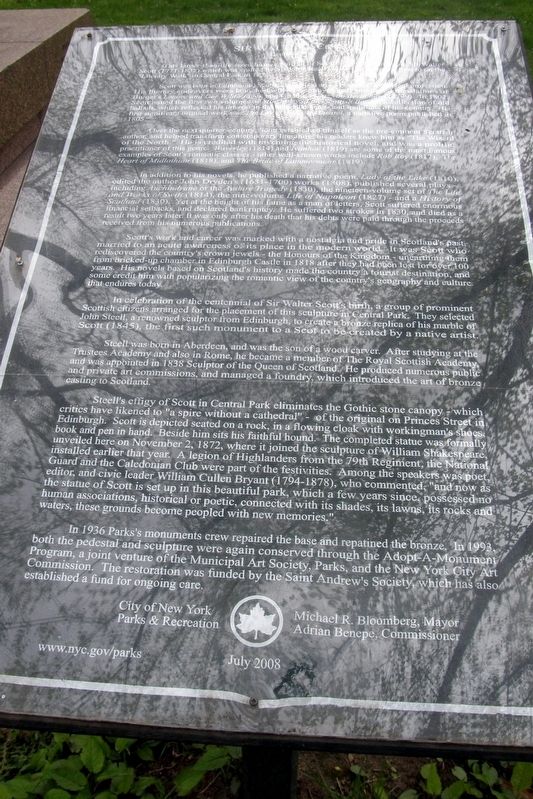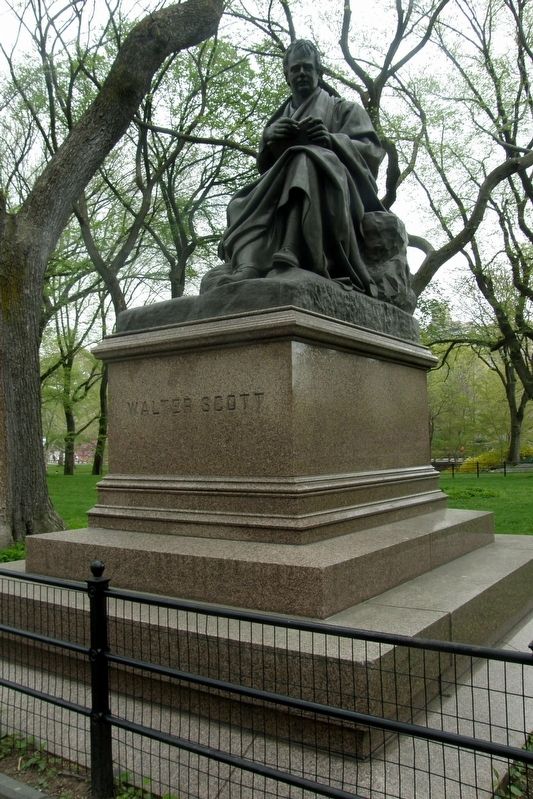Central Park West Historic District in Manhattan in New York County, New York — The American Northeast (Mid-Atlantic)
Sir Walter Scott
This larger-than-life-sized bronze portrait of Scottish novelist and poet Sir Walter Scott (1771–1832) was dedicated on the “Literary Walk” in Central Park in 1872.
Scott was born in Edinburgh, Scotland, and had an early career in the legal profession. His literary endeavors were launched when he anonymously published translations of Burger’s Lenore and Der Wilde Jager, and Goethe’s Gotz von Berlichgen (1799). In 1802, Scott issued the first two volumes of Minstrelsy of the Scottish Border, a collection of old ballads, which reflected his interest in the native language and traditions of his country. His first significant original work was The Lay of the Last Minstrel, a narrative poem published in 1805. Over the next quarter-century, Scott established himself as the pre-eminent Scottish author, and helped transform contemporary literature. He is credited with inventing the historical novel, and was a prolific practitioner of this genre. Waverley (1814) and Ivanhoe (1819) are some of the most famous examples of Scott’s romantic classics. Other well-known works include Rob Roy (1817), The Heart of Midlothian (1818), and The Bride of Lammermoor (1819).
In addition to his novels, he published a narrative poem, Lady of the Lake (1810), edited the author John Dryden’s (1631-1700) works (1808), published several plays, the nineteen-volume set of The Life and Works of Swift (1814), the nine-volume Life of Napoleon (1827), and a History of Scotland (1830). Yet at the height of his fame as a man of letters, Scott suffered enormous financial setbacks and declared bankruptcy. He suffered two strokes in 1830, and died as a result two years later. It was only after his death that his debts were paid through the proceeds received from his numerous publications.
Throughout his career Scott’s work was marked with nostalgia and pride in Scotland’s past married with an acute awareness of its place in the modern world. It was Scott who rediscovered the country’s crown jewels, the Honours of Scotland, unearthing them from bricked-up chamber in Edinburgh Castle in 1818 after they had been lost for over 100 years. His novels based on Scotland’s history made the country a tourist destination, and some credit him with popularizing the romantic view of the country’s geography and culture that endures today.
In celebration of the centennial of Sir Walter Scott’s birth, a group of prominent Scottish citizens arranged for the placement of this sculpture in Central Park. They selected John Steell (1804-1891), a renowned sculptor from Edinburgh, to create a bronze replica of his marble of Scott (1845), the first such monument to a Scot to be created by a native artist.
Steell was born in Aberdeen, and was the son of a wood carver. After studying at the Trustees Academy and also in Rome, he became a member of The Royal Scottish Academy, and was appointed in 1838 Sculptor of the Queen of Scotland. He produced numerous public and private art commissions, and managed a foundry, which introduced the art of bronze casting to Scotland.
Steell’s effigy of Scott in Central Park eliminates the Gothic stone canopy - which critics have likened to “a spire without a cathedral” - of the original on Princes Street in Edinburgh. Scott is depicted seated on a rock, in a flowing cloak with workingman’s shoes, with book and pen in hand. Beside him sits his faithful hound. The completed statue was formally unveiled here on November 2, 1872, where it joined the sculpture of William Shakespeare, installed earlier that year. A legion of Highlanders from the 79th Regiment, the National Guard and the Caledonian Club were part of the festivities. Among the speakers was poet, editor, and civic leader William Cullen Bryant (1794–1878), who commented, “and now as the statue of Scott is set up in this beautiful park, which a few years since, possessed no human associations, historical or poetic, connected with its shades, its lawns, its rocks and waters, these grounds become peopled with new memories.”
In 1936 NYC Parks’ monuments crew repaired the base and repatinated the bronze. In 1993, both the pedestal and sculpture were again conserved through the Adopt-A-Monument Program, a joint venture of the Municipal Art Society, NYC Parks, and the New York City Art Commission (now the Public Design Commission). The restoration was funded by the Saint Andrew’s Society, which has also established a fund for ongoing care.
Erected 2008 by New York City Parks and Recreation.
Topics. This historical marker is listed in this topic list: Arts, Letters, Music. A significant historical year for this entry is 1872.
Location. 40° 46.206′ N, 73° 58.352′ W. Marker is in Manhattan, New York, in New York County. It is in the Central Park West Historic District. Marker can be reached from The Mall. The marker is on The Mall in Central Park in the area known as Literary Walk. Touch for map. Marker is in this post office area: New York NY 10019, United States of America. Touch for directions.
Other nearby markers. At least 8 other markers are within walking distance of this marker. Robert Burns Statue (a few steps from this marker); Columbus (within shouting distance of this marker); William Shakespeare (within shouting distance of this marker); Women's Rights Pioneers Monument (within shouting distance of this marker); William John Liebig (about 300 feet away, measured in a direct line); Welcome to the Dene Slope (about 300 feet away); Balto (about 400 feet away); Transverse Road #1 (about 500 feet away). Touch for a list and map of all markers in Manhattan.
Also see . . . Central Park / Sir Walter Scott. Official NYC Parks description. (Submitted on April 12, 2020, by Larry Gertner of New York, New York.)
Credits. This page was last revised on January 31, 2023. It was originally submitted on September 14, 2017, by Larry Gertner of New York, New York. This page has been viewed 202 times since then and 12 times this year. Last updated on September 15, 2017, by Larry Gertner of New York, New York. Photos: 1, 2. submitted on September 14, 2017, by Larry Gertner of New York, New York. • Bill Pfingsten was the editor who published this page.
Editor’s want-list for this marker. Wide view photo of the marker showing it’s location in context. • Can you help?

